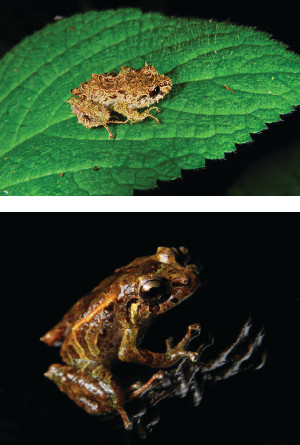discover
SKIN-CHANGING FROG
 Photos: Tim Krynak
Photos: Tim KrynakThe mutable rainfrog can change its skin from rough (top) to smooth.
Deep in a tropical Ecuadorean Andes forest shrouded in darkness and mist, a future Case Western Reserve doctoral student and her biologist husband made an intriguing discovery: a nickel-sized frog with skin so prickly they dubbed it a punk rocker.
But the next morning, Katherine and Tim Krynak stared in dismay at the frog they had collected and placed on a white plastic sheet to be photographed. Its smooth skin suggested they snagged the wrong specimen.
The Krynaks put the frog in a cup with moss to return it to the forest. To their astonishment, the spikes returned. "We couldn't believe our eyes: The frog's skin changed shape to blend with its surroundings," said Katherine Krynak, PhD (GRS '15, biology). "This was totally new to the frog community."
It also is the first documented amphibian species to show such a dramatic ability to change skin textures, the Krynaks and researchers from other universities in the United States and Ecuador reported in an article published this year in The Zoological Journal of the Linnean Society.
The transition by the frog, Pristimantis mutabilis (commonly known as the mutable rainfrog), can take as little as three minutes and likely provides camouflage against predators.
Researchers working with the Krynaks in Ecuador also discovered a related frog species that shares these skin-changing abilities, suggesting the trait might be more common than previously thought. The finds raise new challenges for scientists, who typically use skin texture as a key characteristic to identify distinct amphibians.
"Now that [researchers] know this trait exists, it has implications for how we identify frog species," said Tim Matson, PhD, curator of vertebrate zoology at the Cleveland Museum of Natural History. He was not part of the mutable-frog team. "It's possible frogs identified as separate species could be the same species reacting to different conditions."
During their frequent research trips to Ecuador, the Krynaks—Katherine is now a postdoctoral fellow at the university and at Cleveland Metroparks Zoo; Tim is a project manager at Cleveland Metroparks Natural Resource Division—continue to study the mutable rainfrog, search for new species and aid efforts to conserve the country's forests.
"Ecuador is one of the most biodiverse places on Earth," Katherine said. "There are probably many discoveries yet to be made."






